Harvard Management Company: Private Equity Case Study Analysis
VerifiedAdded on 2020/01/28
|48
|8524
|36
Case Study
AI Summary
This case study analyzes the strategic and financial impact of private equity and venture capital, focusing on the Harvard Management Company (HMC). It explores various aspects including investment strategies, valuation techniques, and exit strategies such as IPOs and trade sales. The study examines the PE and VC life cycle, the application of corporate finance tools like CAPM and DCF, and the valuation process in the PE setting. Furthermore, it assesses the role of Sovereign Wealth Funds in the global economy. The case study delves into the main categories of private investing, including leveraged buyouts, venture capital, growth equity, and real estate, with an emphasis on HMC's investment approach and its hybrid investment model. The analysis covers deal financing, the investment dealing process, and the performance of HMC's endowment, highlighting the returns from private equity and venture capital investments. The case study highlights the challenges and opportunities in the private equity landscape.

Case study
1
1
Paraphrase This Document
Need a fresh take? Get an instant paraphrase of this document with our AI Paraphraser

TABLE OF CONTENTS
Module Aims ..................................................................................................................................3
SECTION A.....................................................................................................................................5
SECTION B...................................................................................................................................25
SECTION C...................................................................................................................................33
2
Module Aims ..................................................................................................................................3
SECTION A.....................................................................................................................................5
SECTION B...................................................................................................................................25
SECTION C...................................................................................................................................33
2
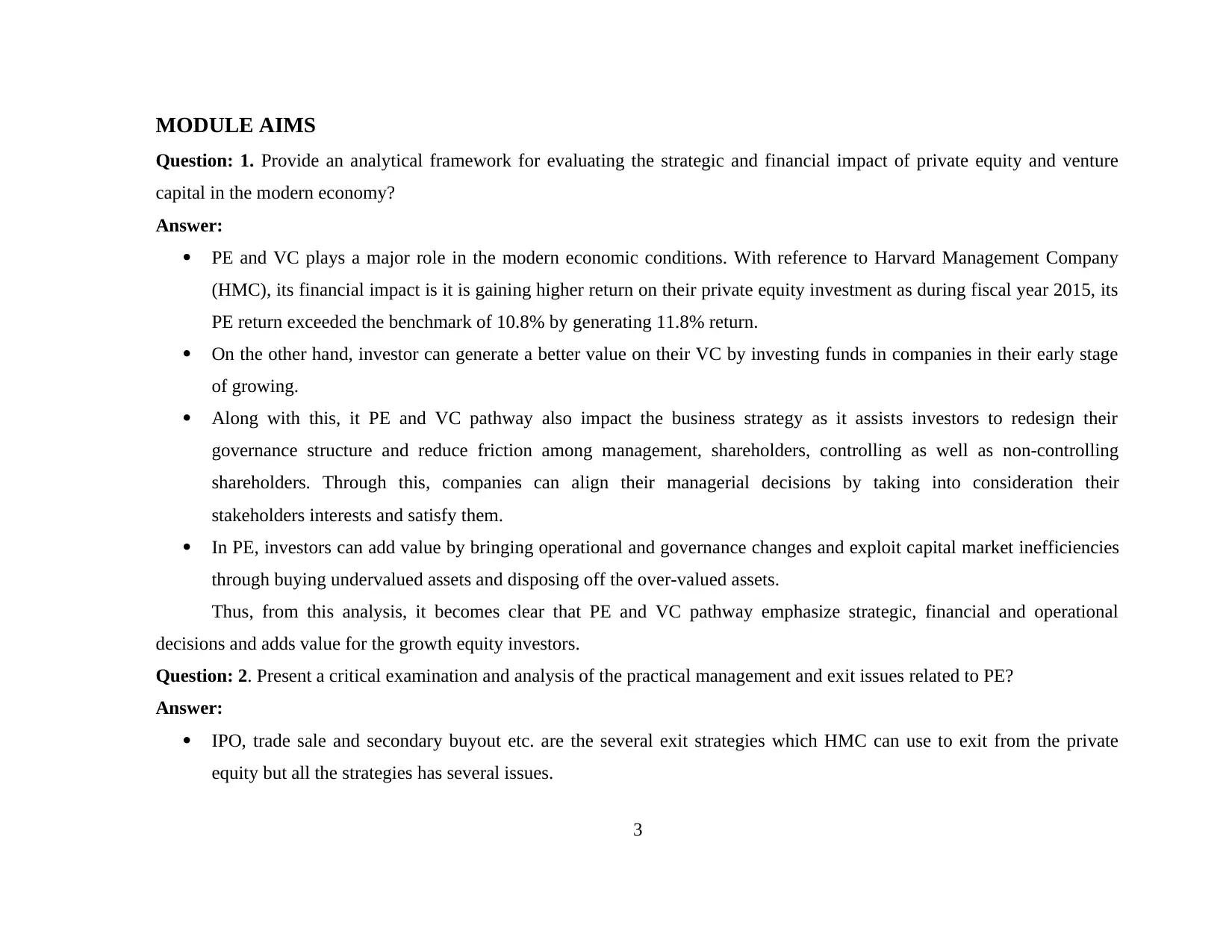
MODULE AIMS
Question: 1. Provide an analytical framework for evaluating the strategic and financial impact of private equity and venture
capital in the modern economy?
Answer:
PE and VC plays a major role in the modern economic conditions. With reference to Harvard Management Company
(HMC), its financial impact is it is gaining higher return on their private equity investment as during fiscal year 2015, its
PE return exceeded the benchmark of 10.8% by generating 11.8% return.
On the other hand, investor can generate a better value on their VC by investing funds in companies in their early stage
of growing.
Along with this, it PE and VC pathway also impact the business strategy as it assists investors to redesign their
governance structure and reduce friction among management, shareholders, controlling as well as non-controlling
shareholders. Through this, companies can align their managerial decisions by taking into consideration their
stakeholders interests and satisfy them.
In PE, investors can add value by bringing operational and governance changes and exploit capital market inefficiencies
through buying undervalued assets and disposing off the over-valued assets.
Thus, from this analysis, it becomes clear that PE and VC pathway emphasize strategic, financial and operational
decisions and adds value for the growth equity investors.
Question: 2. Present a critical examination and analysis of the practical management and exit issues related to PE?
Answer:
IPO, trade sale and secondary buyout etc. are the several exit strategies which HMC can use to exit from the private
equity but all the strategies has several issues.
3
Question: 1. Provide an analytical framework for evaluating the strategic and financial impact of private equity and venture
capital in the modern economy?
Answer:
PE and VC plays a major role in the modern economic conditions. With reference to Harvard Management Company
(HMC), its financial impact is it is gaining higher return on their private equity investment as during fiscal year 2015, its
PE return exceeded the benchmark of 10.8% by generating 11.8% return.
On the other hand, investor can generate a better value on their VC by investing funds in companies in their early stage
of growing.
Along with this, it PE and VC pathway also impact the business strategy as it assists investors to redesign their
governance structure and reduce friction among management, shareholders, controlling as well as non-controlling
shareholders. Through this, companies can align their managerial decisions by taking into consideration their
stakeholders interests and satisfy them.
In PE, investors can add value by bringing operational and governance changes and exploit capital market inefficiencies
through buying undervalued assets and disposing off the over-valued assets.
Thus, from this analysis, it becomes clear that PE and VC pathway emphasize strategic, financial and operational
decisions and adds value for the growth equity investors.
Question: 2. Present a critical examination and analysis of the practical management and exit issues related to PE?
Answer:
IPO, trade sale and secondary buyout etc. are the several exit strategies which HMC can use to exit from the private
equity but all the strategies has several issues.
3
⊘ This is a preview!⊘
Do you want full access?
Subscribe today to unlock all pages.

Trusted by 1+ million students worldwide
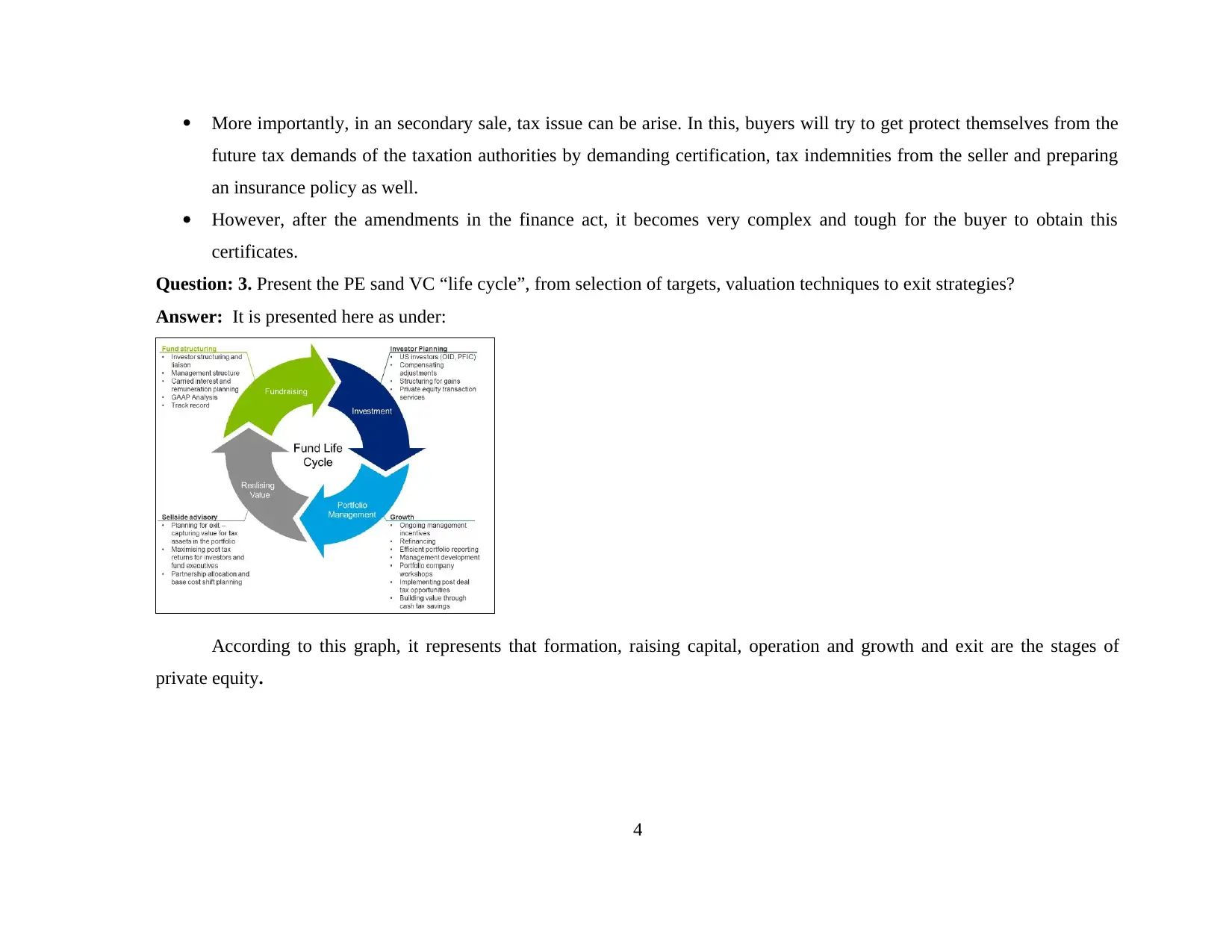
More importantly, in an secondary sale, tax issue can be arise. In this, buyers will try to get protect themselves from the
future tax demands of the taxation authorities by demanding certification, tax indemnities from the seller and preparing
an insurance policy as well.
However, after the amendments in the finance act, it becomes very complex and tough for the buyer to obtain this
certificates.
Question: 3. Present the PE sand VC “life cycle”, from selection of targets, valuation techniques to exit strategies?
Answer: It is presented here as under:
According to this graph, it represents that formation, raising capital, operation and growth and exit are the stages of
private equity.
4
future tax demands of the taxation authorities by demanding certification, tax indemnities from the seller and preparing
an insurance policy as well.
However, after the amendments in the finance act, it becomes very complex and tough for the buyer to obtain this
certificates.
Question: 3. Present the PE sand VC “life cycle”, from selection of targets, valuation techniques to exit strategies?
Answer: It is presented here as under:
According to this graph, it represents that formation, raising capital, operation and growth and exit are the stages of
private equity.
4
Paraphrase This Document
Need a fresh take? Get an instant paraphrase of this document with our AI Paraphraser
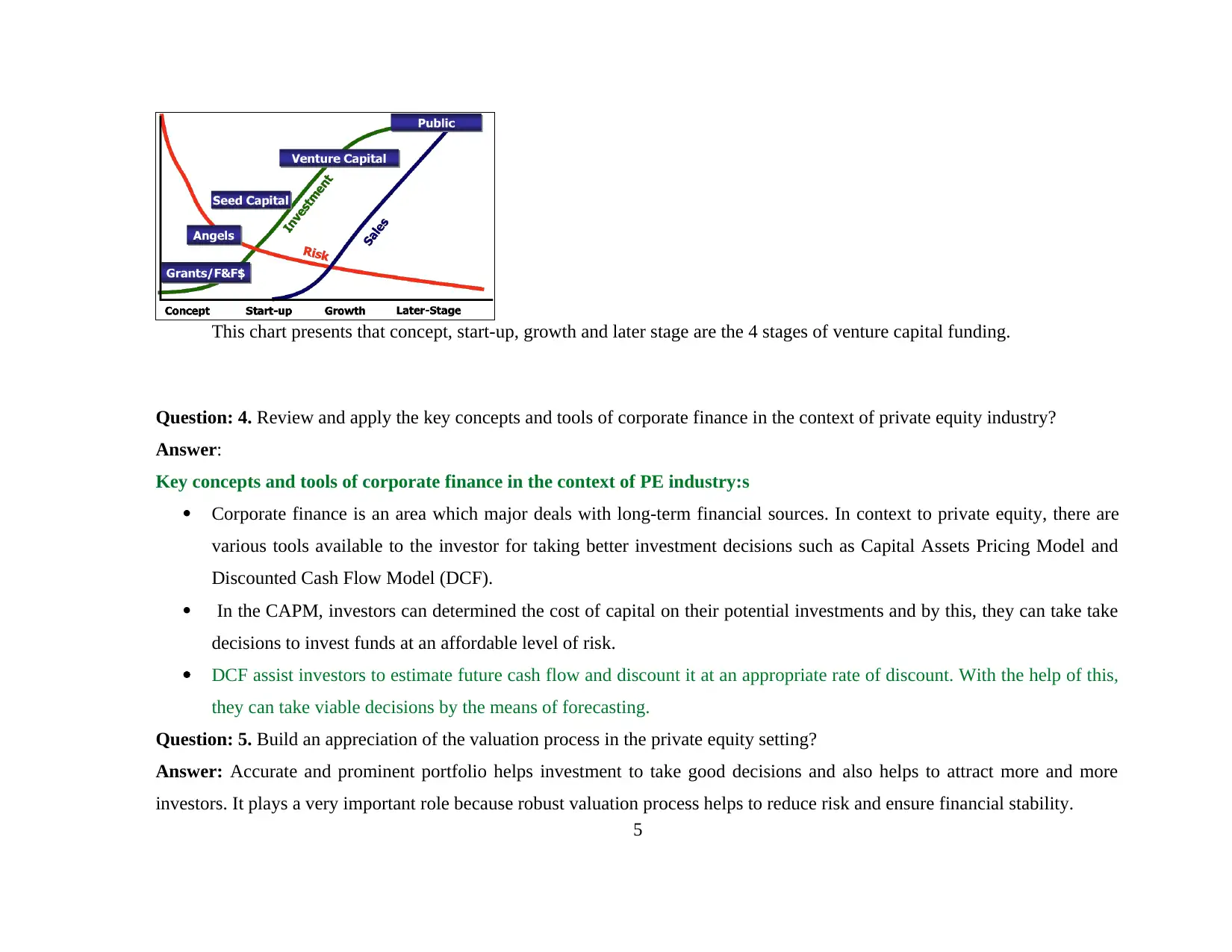
This chart presents that concept, start-up, growth and later stage are the 4 stages of venture capital funding.
Question: 4. Review and apply the key concepts and tools of corporate finance in the context of private equity industry?
Answer:
Key concepts and tools of corporate finance in the context of PE industry:s
Corporate finance is an area which major deals with long-term financial sources. In context to private equity, there are
various tools available to the investor for taking better investment decisions such as Capital Assets Pricing Model and
Discounted Cash Flow Model (DCF).
In the CAPM, investors can determined the cost of capital on their potential investments and by this, they can take take
decisions to invest funds at an affordable level of risk.
DCF assist investors to estimate future cash flow and discount it at an appropriate rate of discount. With the help of this,
they can take viable decisions by the means of forecasting.
Question: 5. Build an appreciation of the valuation process in the private equity setting?
Answer: Accurate and prominent portfolio helps investment to take good decisions and also helps to attract more and more
investors. It plays a very important role because robust valuation process helps to reduce risk and ensure financial stability.
5
Question: 4. Review and apply the key concepts and tools of corporate finance in the context of private equity industry?
Answer:
Key concepts and tools of corporate finance in the context of PE industry:s
Corporate finance is an area which major deals with long-term financial sources. In context to private equity, there are
various tools available to the investor for taking better investment decisions such as Capital Assets Pricing Model and
Discounted Cash Flow Model (DCF).
In the CAPM, investors can determined the cost of capital on their potential investments and by this, they can take take
decisions to invest funds at an affordable level of risk.
DCF assist investors to estimate future cash flow and discount it at an appropriate rate of discount. With the help of this,
they can take viable decisions by the means of forecasting.
Question: 5. Build an appreciation of the valuation process in the private equity setting?
Answer: Accurate and prominent portfolio helps investment to take good decisions and also helps to attract more and more
investors. It plays a very important role because robust valuation process helps to reduce risk and ensure financial stability.
5
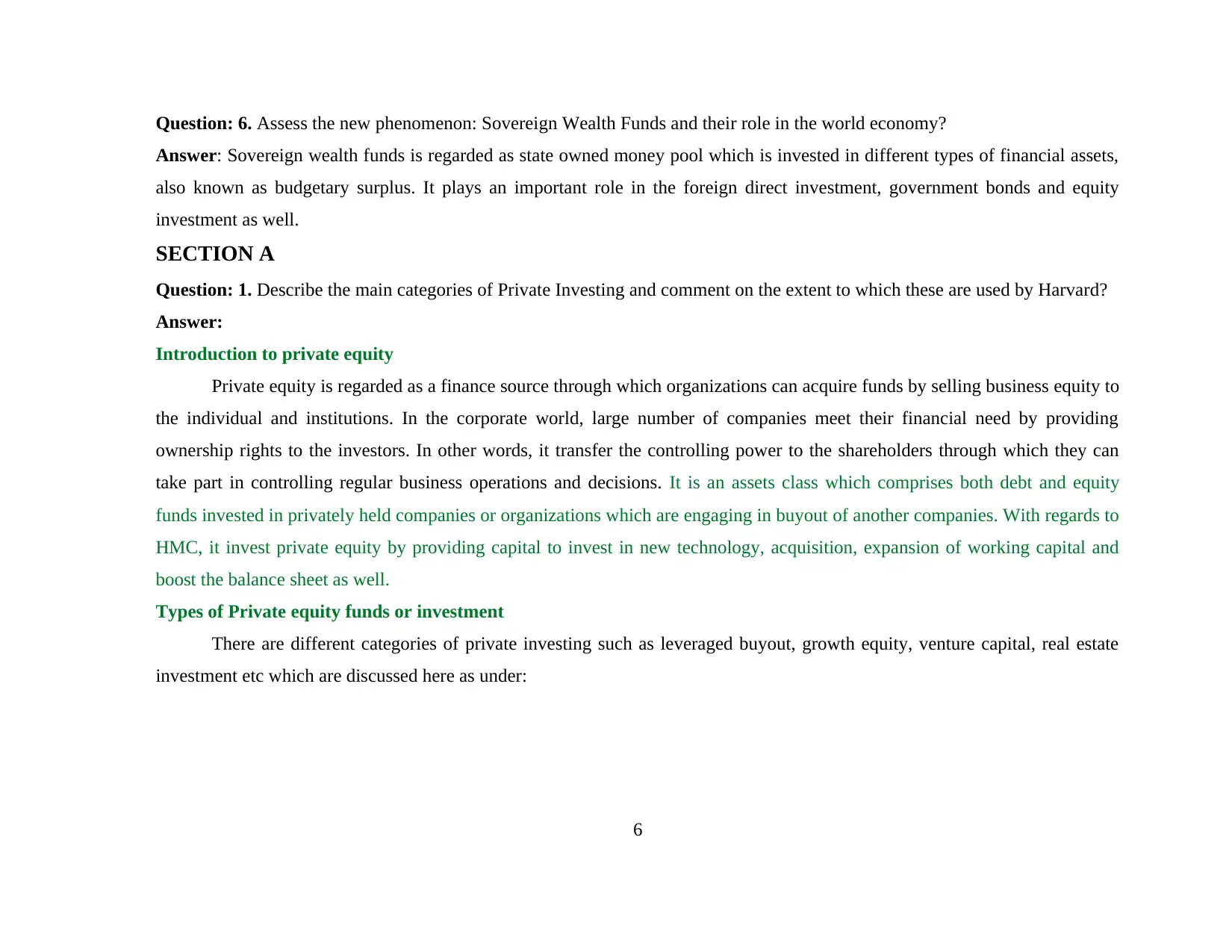
Question: 6. Assess the new phenomenon: Sovereign Wealth Funds and their role in the world economy?
Answer: Sovereign wealth funds is regarded as state owned money pool which is invested in different types of financial assets,
also known as budgetary surplus. It plays an important role in the foreign direct investment, government bonds and equity
investment as well.
SECTION A
Question: 1. Describe the main categories of Private Investing and comment on the extent to which these are used by Harvard?
Answer:
Introduction to private equity
Private equity is regarded as a finance source through which organizations can acquire funds by selling business equity to
the individual and institutions. In the corporate world, large number of companies meet their financial need by providing
ownership rights to the investors. In other words, it transfer the controlling power to the shareholders through which they can
take part in controlling regular business operations and decisions. It is an assets class which comprises both debt and equity
funds invested in privately held companies or organizations which are engaging in buyout of another companies. With regards to
HMC, it invest private equity by providing capital to invest in new technology, acquisition, expansion of working capital and
boost the balance sheet as well.
Types of Private equity funds or investment
There are different categories of private investing such as leveraged buyout, growth equity, venture capital, real estate
investment etc which are discussed here as under:
6
Answer: Sovereign wealth funds is regarded as state owned money pool which is invested in different types of financial assets,
also known as budgetary surplus. It plays an important role in the foreign direct investment, government bonds and equity
investment as well.
SECTION A
Question: 1. Describe the main categories of Private Investing and comment on the extent to which these are used by Harvard?
Answer:
Introduction to private equity
Private equity is regarded as a finance source through which organizations can acquire funds by selling business equity to
the individual and institutions. In the corporate world, large number of companies meet their financial need by providing
ownership rights to the investors. In other words, it transfer the controlling power to the shareholders through which they can
take part in controlling regular business operations and decisions. It is an assets class which comprises both debt and equity
funds invested in privately held companies or organizations which are engaging in buyout of another companies. With regards to
HMC, it invest private equity by providing capital to invest in new technology, acquisition, expansion of working capital and
boost the balance sheet as well.
Types of Private equity funds or investment
There are different categories of private investing such as leveraged buyout, growth equity, venture capital, real estate
investment etc which are discussed here as under:
6
⊘ This is a preview!⊘
Do you want full access?
Subscribe today to unlock all pages.

Trusted by 1+ million students worldwide
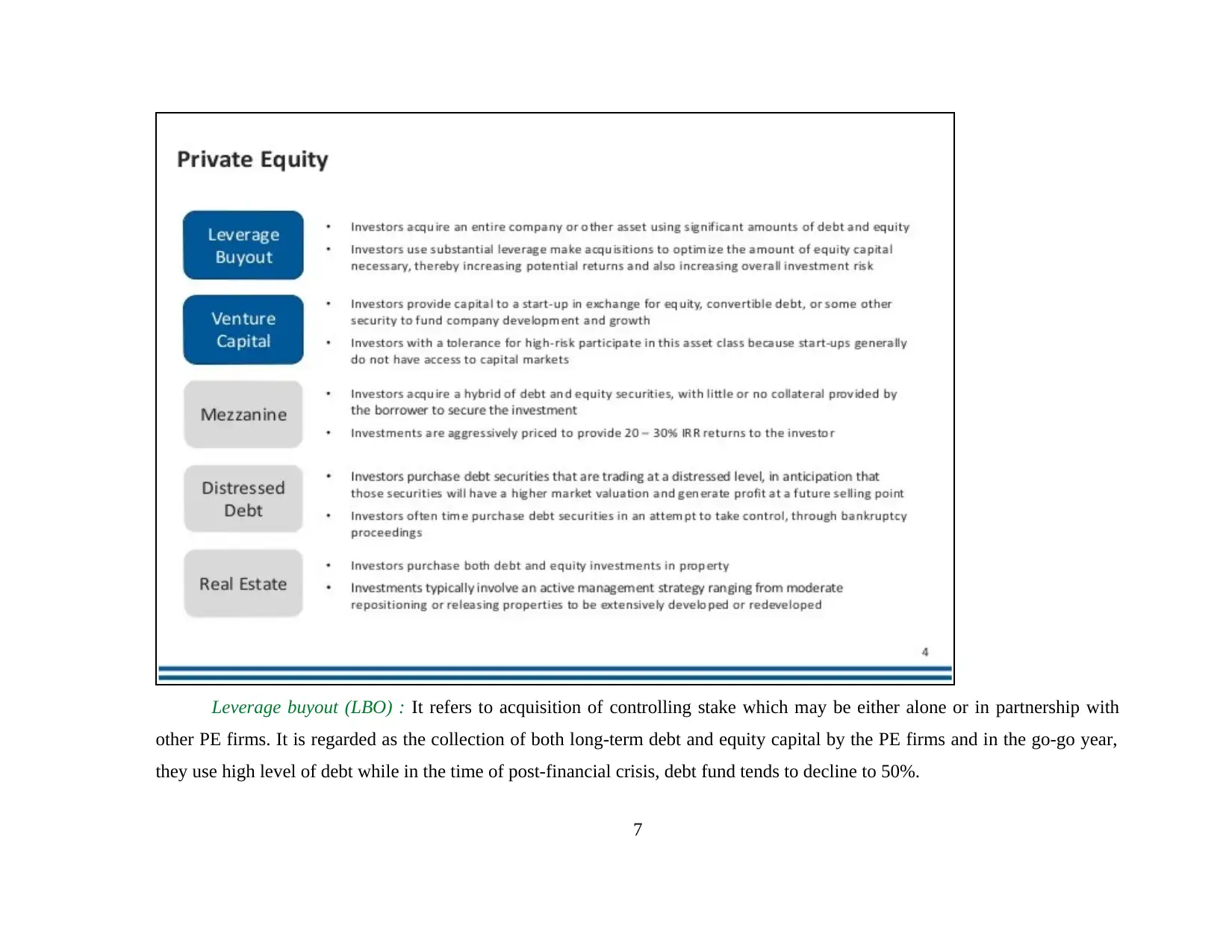
Leverage buyout (LBO) : It refers to acquisition of controlling stake which may be either alone or in partnership with
other PE firms. It is regarded as the collection of both long-term debt and equity capital by the PE firms and in the go-go year,
they use high level of debt while in the time of post-financial crisis, debt fund tends to decline to 50%.
7
other PE firms. It is regarded as the collection of both long-term debt and equity capital by the PE firms and in the go-go year,
they use high level of debt while in the time of post-financial crisis, debt fund tends to decline to 50%.
7
Paraphrase This Document
Need a fresh take? Get an instant paraphrase of this document with our AI Paraphraser
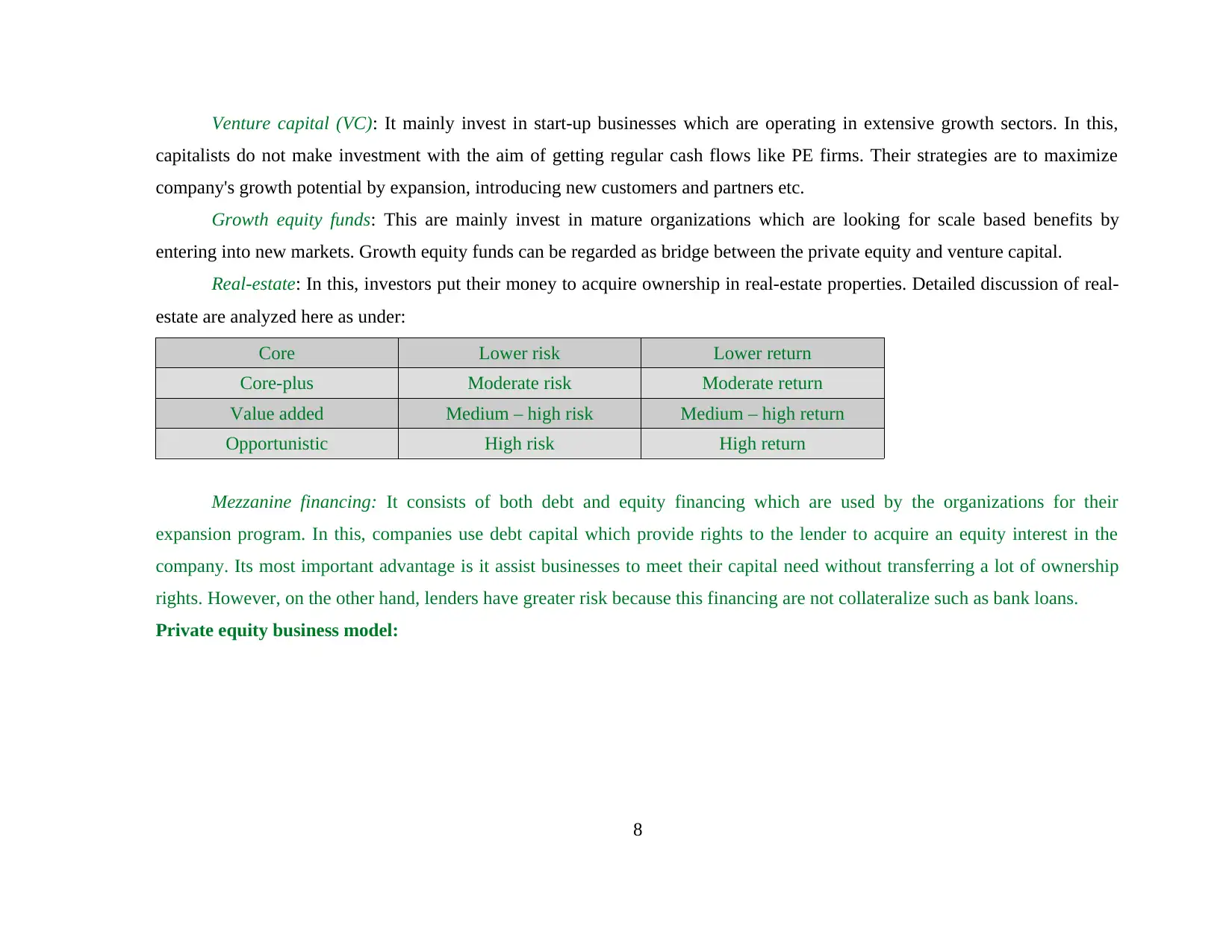
Venture capital (VC): It mainly invest in start-up businesses which are operating in extensive growth sectors. In this,
capitalists do not make investment with the aim of getting regular cash flows like PE firms. Their strategies are to maximize
company's growth potential by expansion, introducing new customers and partners etc.
Growth equity funds: This are mainly invest in mature organizations which are looking for scale based benefits by
entering into new markets. Growth equity funds can be regarded as bridge between the private equity and venture capital.
Real-estate: In this, investors put their money to acquire ownership in real-estate properties. Detailed discussion of real-
estate are analyzed here as under:
Core Lower risk Lower return
Core-plus Moderate risk Moderate return
Value added Medium – high risk Medium – high return
Opportunistic High risk High return
Mezzanine financing: It consists of both debt and equity financing which are used by the organizations for their
expansion program. In this, companies use debt capital which provide rights to the lender to acquire an equity interest in the
company. Its most important advantage is it assist businesses to meet their capital need without transferring a lot of ownership
rights. However, on the other hand, lenders have greater risk because this financing are not collateralize such as bank loans.
Private equity business model:
8
capitalists do not make investment with the aim of getting regular cash flows like PE firms. Their strategies are to maximize
company's growth potential by expansion, introducing new customers and partners etc.
Growth equity funds: This are mainly invest in mature organizations which are looking for scale based benefits by
entering into new markets. Growth equity funds can be regarded as bridge between the private equity and venture capital.
Real-estate: In this, investors put their money to acquire ownership in real-estate properties. Detailed discussion of real-
estate are analyzed here as under:
Core Lower risk Lower return
Core-plus Moderate risk Moderate return
Value added Medium – high risk Medium – high return
Opportunistic High risk High return
Mezzanine financing: It consists of both debt and equity financing which are used by the organizations for their
expansion program. In this, companies use debt capital which provide rights to the lender to acquire an equity interest in the
company. Its most important advantage is it assist businesses to meet their capital need without transferring a lot of ownership
rights. However, on the other hand, lenders have greater risk because this financing are not collateralize such as bank loans.
Private equity business model:
8
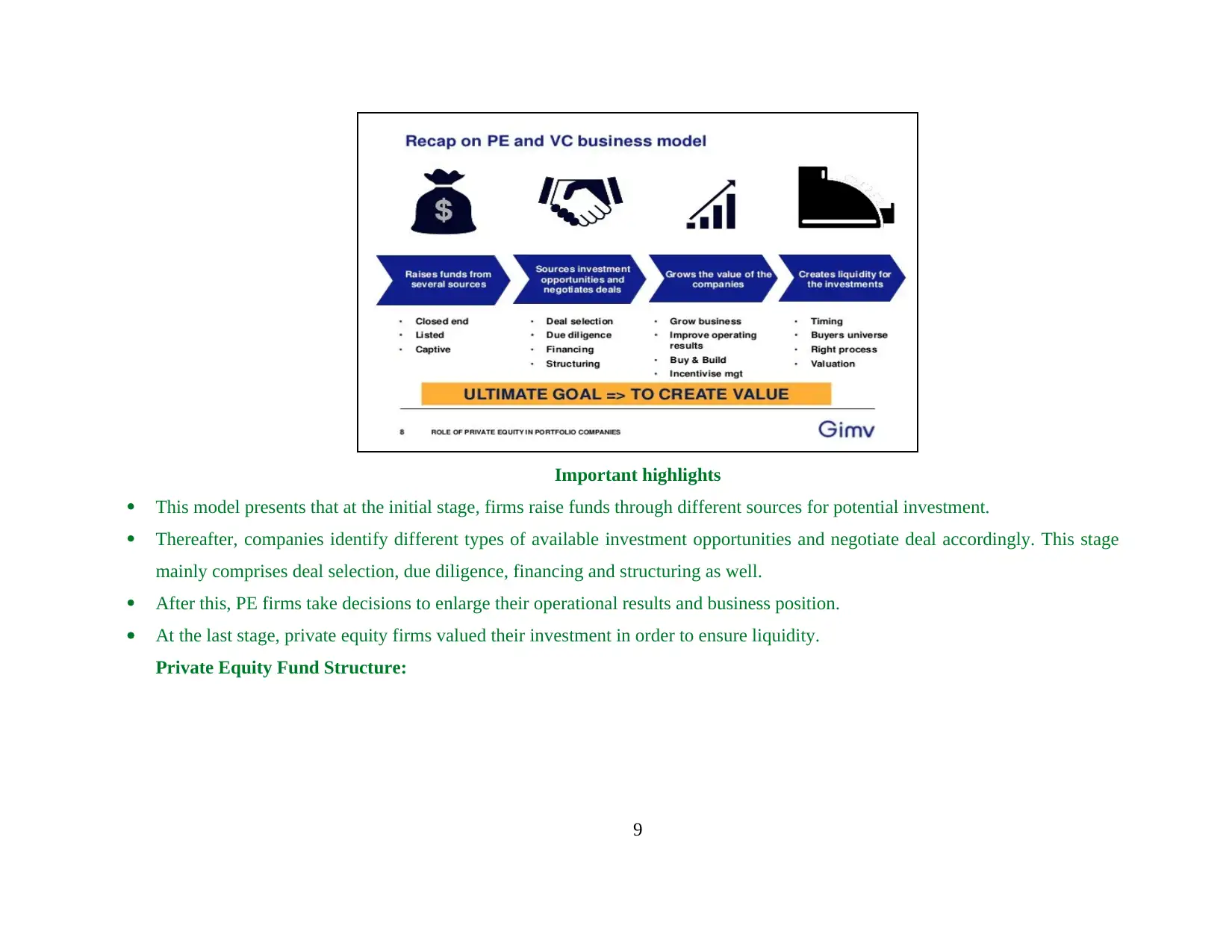
Important highlights
This model presents that at the initial stage, firms raise funds through different sources for potential investment.
Thereafter, companies identify different types of available investment opportunities and negotiate deal accordingly. This stage
mainly comprises deal selection, due diligence, financing and structuring as well.
After this, PE firms take decisions to enlarge their operational results and business position.
At the last stage, private equity firms valued their investment in order to ensure liquidity.
Private Equity Fund Structure:
9
This model presents that at the initial stage, firms raise funds through different sources for potential investment.
Thereafter, companies identify different types of available investment opportunities and negotiate deal accordingly. This stage
mainly comprises deal selection, due diligence, financing and structuring as well.
After this, PE firms take decisions to enlarge their operational results and business position.
At the last stage, private equity firms valued their investment in order to ensure liquidity.
Private Equity Fund Structure:
9
⊘ This is a preview!⊘
Do you want full access?
Subscribe today to unlock all pages.

Trusted by 1+ million students worldwide
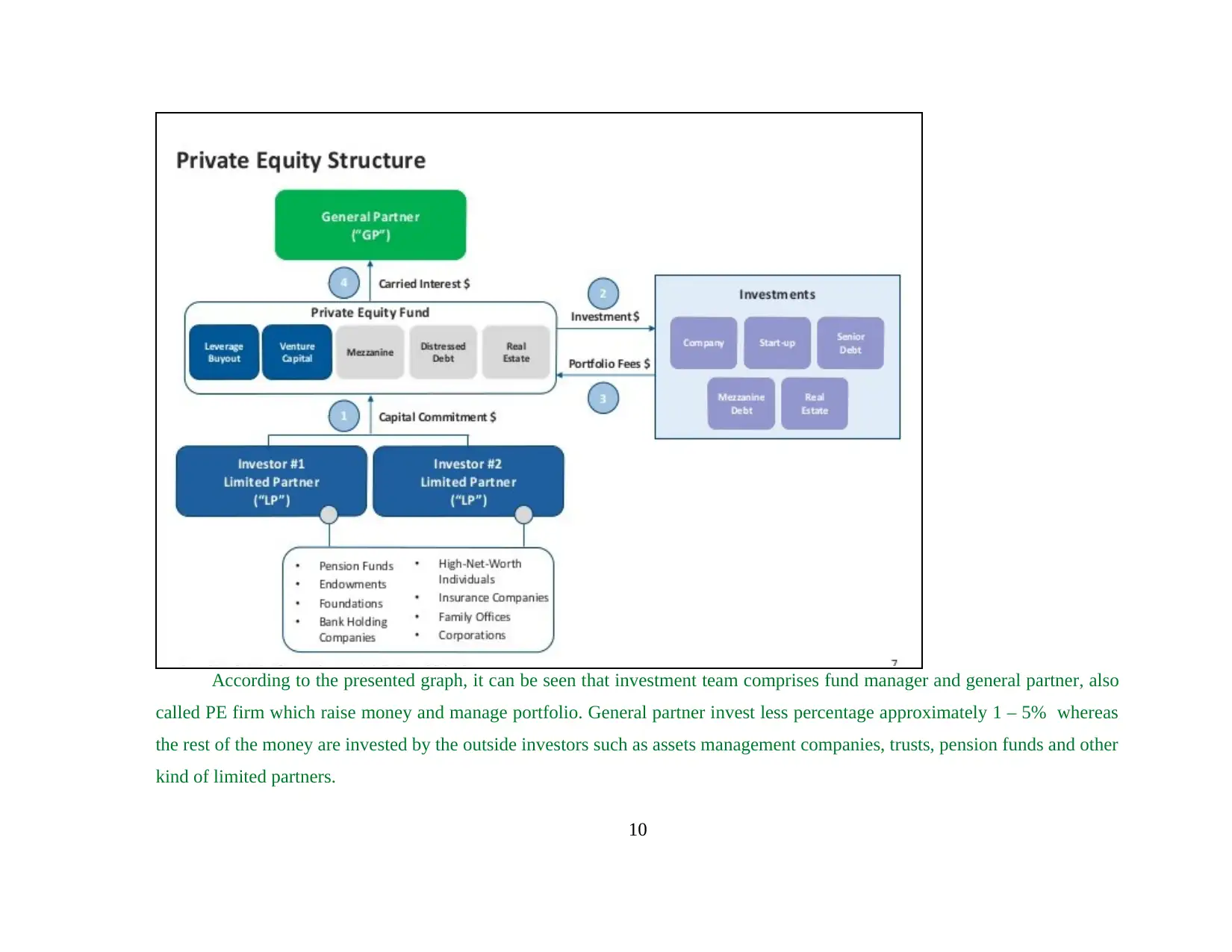
According to the presented graph, it can be seen that investment team comprises fund manager and general partner, also
called PE firm which raise money and manage portfolio. General partner invest less percentage approximately 1 – 5% whereas
the rest of the money are invested by the outside investors such as assets management companies, trusts, pension funds and other
kind of limited partners.
10
called PE firm which raise money and manage portfolio. General partner invest less percentage approximately 1 – 5% whereas
the rest of the money are invested by the outside investors such as assets management companies, trusts, pension funds and other
kind of limited partners.
10
Paraphrase This Document
Need a fresh take? Get an instant paraphrase of this document with our AI Paraphraser
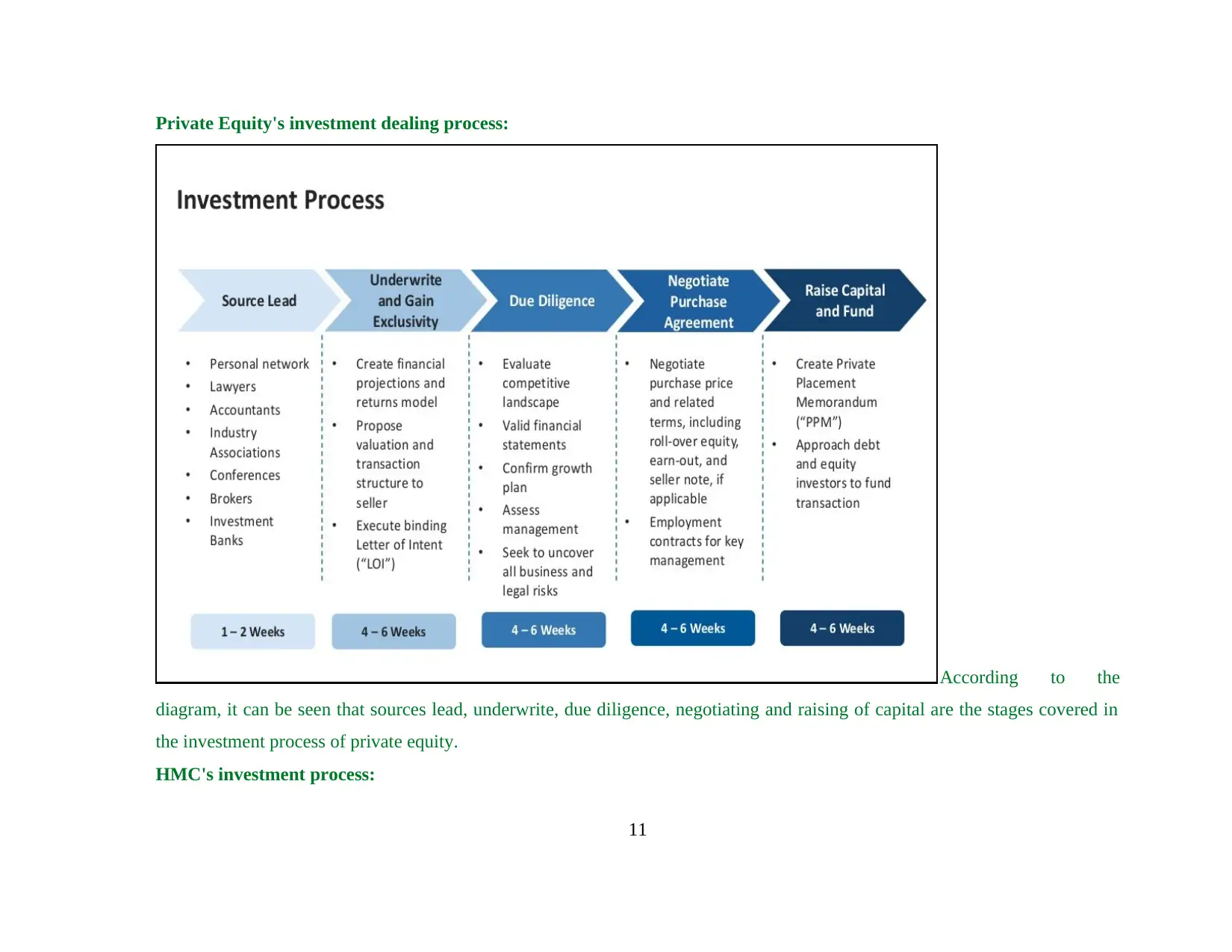
Private Equity's investment dealing process:
According to the
diagram, it can be seen that sources lead, underwrite, due diligence, negotiating and raising of capital are the stages covered in
the investment process of private equity.
HMC's investment process:
11
According to the
diagram, it can be seen that sources lead, underwrite, due diligence, negotiating and raising of capital are the stages covered in
the investment process of private equity.
HMC's investment process:
11
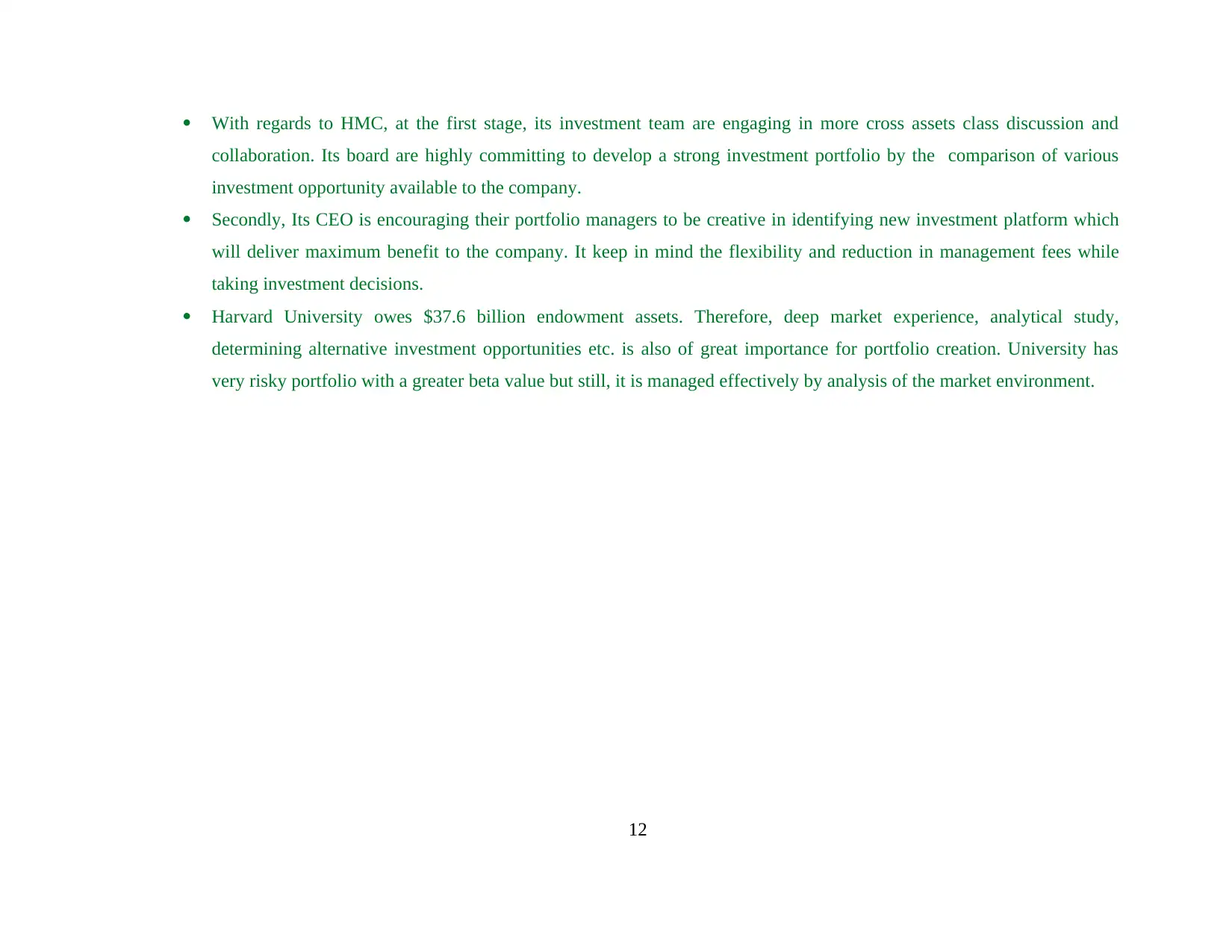
With regards to HMC, at the first stage, its investment team are engaging in more cross assets class discussion and
collaboration. Its board are highly committing to develop a strong investment portfolio by the comparison of various
investment opportunity available to the company.
Secondly, Its CEO is encouraging their portfolio managers to be creative in identifying new investment platform which
will deliver maximum benefit to the company. It keep in mind the flexibility and reduction in management fees while
taking investment decisions.
Harvard University owes $37.6 billion endowment assets. Therefore, deep market experience, analytical study,
determining alternative investment opportunities etc. is also of great importance for portfolio creation. University has
very risky portfolio with a greater beta value but still, it is managed effectively by analysis of the market environment.
12
collaboration. Its board are highly committing to develop a strong investment portfolio by the comparison of various
investment opportunity available to the company.
Secondly, Its CEO is encouraging their portfolio managers to be creative in identifying new investment platform which
will deliver maximum benefit to the company. It keep in mind the flexibility and reduction in management fees while
taking investment decisions.
Harvard University owes $37.6 billion endowment assets. Therefore, deep market experience, analytical study,
determining alternative investment opportunities etc. is also of great importance for portfolio creation. University has
very risky portfolio with a greater beta value but still, it is managed effectively by analysis of the market environment.
12
⊘ This is a preview!⊘
Do you want full access?
Subscribe today to unlock all pages.

Trusted by 1+ million students worldwide
1 out of 48
Related Documents
Your All-in-One AI-Powered Toolkit for Academic Success.
+13062052269
info@desklib.com
Available 24*7 on WhatsApp / Email
![[object Object]](/_next/static/media/star-bottom.7253800d.svg)
Unlock your academic potential
Copyright © 2020–2025 A2Z Services. All Rights Reserved. Developed and managed by ZUCOL.





